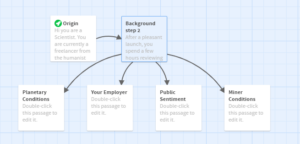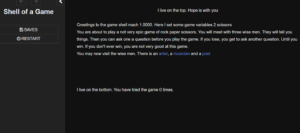An Interactive Fiction Game for Information Literacy in STEM Courses
Dana Atwood-Blaine, University of Northern Iowa; David Grant, University of Northern Iowa; Anne Marie Gruber, University of Northern Iowa
Catalog Description
This is a digital interactive fiction game for undergraduate STEM students to “choose their own adventure” and engage in, practice, and learn information literacy skills. Within a science-fiction scenario with characters crafted to reflect diversity in science, students will evaluate and act upon provided information types and sources to understand a mysterious set of events that unfold on their arrival at an outpost on Saturn’s moon, Titan. Gameplay and post-play reflective activities will require critical thinking, problem-solving, and dealing with ambiguity in order to unravel different potential endings about the existence of an extraterrestrial life form. Thus, effective gameplay will require players to draw upon foundational, meta, and humanistic knowledge domains.
This project is based upon work supported by the Iowa Space Grant Consortium under NASA Award No. 80NSSC20M0107.
Program Summary
In an environment with mis- and disinformation, particularly regarding science content, it has become increasingly important to teach students how to discern and selectively consume across a spectrum of information sources. This project entails developing a web-based interactive fiction game to support information literacy in undergraduate STEM Education courses. As our university re-envisions its General Education sequence, there is a perceived need and opportunity to address metaknowledge and humanistic dimensions in all required courses. The game-based tool, built with the platform Twine, will allow students to engage with information literacy practices outside the classroom as they make contextual choices based on the quality and reliability of the information presented. Subsequently, students will reflect on their choices during gameplay to gain metaknowledge about information literacy.
Our audience will be primarily pre-service STEM education and STEM majors. To meet these students early in their curriculum, the courses will be General Education science courses. We envision course integration through partnerships in Biology, Physics, Chemistry, Science Education, Technical Communication, and the university library. Faculty who incorporate the game within courses will be provided disciplinary examples of mis- and disinformation issues and ancillaries such as reflective discussion questions.
Program Goals
- This program addresses the following knowledge domains:
- Humanistic knowledge: Game characters will be designed to reflect diversity in many forms to allow players to see themselves reflected, especially if not traditionally part of the majority in STEM. Scenarios require ethical reasoning to make particular choices.
- Meta knowledge: Gameplay and reflective activities will require critical thinking, problem-solving, and dealing with ambiguity and problems with no clear path to a solution.
- Foundational knowledge: While core content knowledge in the sciences isn’t a prerequisite for gameplay, information literacy skills are the key focus and cross-disciplinary knowledge will be emphasized. Students will engage with information literacy issues relevant to STEM education.
- This program will:
- Craft an interactive experience that strengthens students’ information literacy skills.
- Discover what kinds of information students value in making in-game decisions to meet goals.
- Provide actively inclusive game space for students.
- Foster conversations among faculty and staff about integrating information literacy in their pedagogies and curricula.
Student Learning Outcomes
- Learning Outcome 1
Students will recognize how the need for information may help to determine the level of authority required. - Learning Outcome 2
Students will assess the quality of the claims and evidence used to support them. - Learning Outcome 3
Students will demonstrate an understanding of the nature of science through identifying the strongest argument or claim. - Learning Outcome 4
Students will identify the most effective explanation of a science concept for a particular audience. - Note: This program supports the UNI General Education critical thinking student learning outcome.
Assessing Program Goals
Decision-making data from within gameplay will be quantitatively analyzed to determine how students valued and navigated conflicting and/or contrasting information in order to achieve game goal(s).
We will use control groups to evaluate effectiveness of the game itself. A common writing assignment based on provided sources will be given to both the game-playing group and a control group to compare information literacy outcomes.
Students will write reflections from a prompt about their own metacognitive awareness as it relates to information literacy. This will be scored using a rubric and those scores will be aggregated to determine program effectiveness.
Student and faculty feedback will be gathered regarding gameplay and connection with course/program goals.
Assessing Student Learning Outcomes
Students’ written reflections will be scored against a rubric [Outcomes 1 & 2].
- Reflections will also be analyzed qualitatively to determine how students evaluate claims and evidence [Outcome 4].
Students will respond to decision-making scenarios within the common writing assignment after gameplay. Writing rubric will be adapted from an informed source to ensure both validity and reliability [Outcomes 3 & 4].
Game Description
The program exemplar provides a description of the game and decide how each choice tells us about the player’s information literacy skills.
Interactive Fiction Game for Information Literacy Description
Dana Atwood-Blaine, University of Northern Iowa; David Grant, University of Northern Iowa; Anne Marie Gruber, University of Northern Iowa
Summary
In this activity, students will play our proposed interactive fiction game built with the free software Twine (https://twinery.org/). Twine is a digital “choose your own adventure” platform where player choices lead them through different unfoldings of the plot (see figure 1).
This allows the construction of decision-trees we as researchers can use to better understand student decision-making about information literacy as it intersects scientific and STEM literacy.
Optimally, gameplay will occur outside of class time since it will require varying amounts of time to complete (see image example of player’s view, below). Students will make specific choices regarding contrasting and/or conflicting sources of information in a science-fiction scenario set on Saturn’s moon, Titan. Completing the game will not lead to a single, pre-determined success or failure, but a range of possible conclusions so that different choices can reveal different outcomes and more accurately reflect the challenges when working with information rather than true/false binaries (ACRL, 2016; Caulfield, 2017). Researchers will be able to determine what players value in terms of source credibility, in an environment where there is not necessarily a clear “correct” answer. Students will be able to play the game multiple times (see example 2 for player view of gameplay).
Faculty incorporating the game within their courses will be provided reflection/discussion prompts to use following gameplay. The game supports information literacy learning. Note: This project/material is based upon work supported by the Iowa Space Grant Consortium under NASA Award No. 80NSSC20M0107. Data collected in Spring 2021will be instrumental in helping shape the actual outcomes and assessments for the final tool.
Context for Use
Type and level of course
The interactive fiction game is designed for use in general education science courses, which will primarily include lower-level undergraduate students.
Skills and concepts students should have mastered
Students need not have had extensive mastery of science concepts.
How the activity is situated in the course
Instructors choose to have this prototype piloted in their course as they see fit. Gameplay happens outside class time with an in-class reflective component that may include discussion questions and/or writing prompts connecting it to course/ program learning goals.
Design Goals
This interactive fiction activity requires students to demonstrate information literacy and rhetorical awareness as they make choices relying on provided source material within game scenarios, ideally bringing the narrative to an optimal conclusion. Game design will require players to make decisions informed by a variety of sources. For example, players will be provided with information within interpersonal, organizational, or research-based scenarios. Thus, players will be required to make choices based upon information stemming from different research sponsors, conflicting findings, dubious motives, etc. Students can replay the game multiple times to explore different choices and possible endings.
Description and Materials
Preparation Prior To Class (PIs/instructor)
- Create player and control groups.
- Ensuring technology access for students without desktop/laptop.
- Develop script to introduce the activity to students.
The Game/ Gameplay
Twine game interface, which sets up a “choose your own adventure” model in which game players make discrete choices that impact the game plot. Game goal: discovery of a new species of methane-based life.
PLOT (under development):
Players assume the role of the Protagonist, a scientist trained in the future study of Informology (draft name), the study of information and truth. On a routine mission to Titan’s methane mines, instructions from a manager are clear but conclude with “I understand, given your service record, the passion and ideals you hold about justice for everyone in the solar system, but the Titan miners are not the type to align yourself if you want to advance.” Whether or not player chooses to engage (a miner will attempt to engage and descriptions of banners advocating anti-Earth sentiment will be included), this will reflect on their performance via branches of the story – updates and information from boss will be relayed in game.
Player must balance conflicting motivations/exigencies and engagement threatens a “good” review. All three areas as bad means player is terminated; game over, man. With requests to engage, miners report damage to equipment and Protagonist’s ship is damaged. But who did it and why? This should happen no matter what the Player chooses and delays their return to Earth, forcing them to solve the mystery while searching for hard-to-find ship components.
Resources on Titan are limited to what the company sends from Earth and a handful of products made on site, mainly 3D printed mining equipment (so no readily accessible part schematics or extra machine to devote to printing them). Deciding on the information to believe and why will be requisite to solve this puzzle.
The easiest assumption players can make is that hostile workers somehow sabotaged it, but this prevents them from discovering the methane-based lifeforms. Players can choose to strip components from mining equipment or other machines (like O2 scrubbers or water purifiers) to fix their ship and eventually leave. For example, worker conditions continue to deteriorate and the mines are forced to close after a disastrous attempt at overthrowing the executives stationed there (possible Bad Ending).
The game remains agnostic on the company and its labor force, but clearly the company discourages players from investigating its very possibility by questioning studies, producing slanted studies of their own, cherry-picking evidence, engaging in rhetorical fallacies, etc. Meanwhile, the miners are also questioning studies, using false appeals (quasi-religious?), formulating conspiracy theories, etc. Players need to balance their own employment with a search for accurate and reliable data.
Objectives thoughts: Cash money, Resource Development, Relations with life forms (human, methane-based) Maintaining “good” in all three areas doesn’t lead to success. Rather, success leads to discovery of a new species of methane-based life.
Instructor Guidance/Resources
Explanation of game and its connection to science education, broadly defined.
Prompts for post-game student reflection/discussion.
Assessment
Assessment strategies will gauge game effectiveness as well as student learning outcomes. See this page for detailed assessment information.
Resources
Association of College & Research Libraries. (2016). Framework for Information Literacy for Higher Education.
Caulfield, M. (2017). Web Literacy for Student Factcheckers.
Kereluik, K., Mishra, P., Fahnoe, C., & Terry, L. (2013). What knowledge is of most worth: Teacher knowledge for 21st century learning. Journal of digital learning in teacher education, 29(4), 127-140.
Twine game examples:

This material is based upon work supported by the National Science Foundation under Grant #1935479: Workshop on the Substance of STEM Education. Any opinions, findings, and conclusions or recommendations expressed in this material are those of the author(s) and do not necessarily reflect the views of the National Science Foundation.


